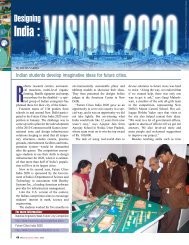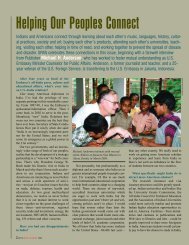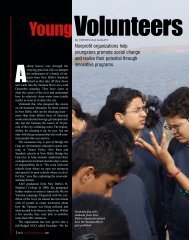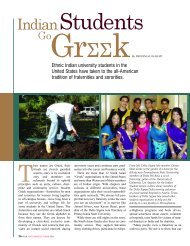You also want an ePaper? Increase the reach of your titles
YUMPU automatically turns print PDFs into web optimized ePapers that Google loves.
John, 16, poses at home in Tennessee behind his parents, Wayne<br />
and Carol, who adopted him in India in 2000. At left is his sister<br />
Jennifer, 7, born in Korea and adopted in 1999; and at right is<br />
his sister Cecilia, 17, born in Guatemala and adopted in 2004.<br />
be a bill so that a child can be ours if we want it,” agreed<br />
Baig, a Christian. The Human Rights Law Network, a legal<br />
group in New Delhi, is working on public interest litigation in<br />
the Supreme Court that aims to liberalize adoption laws.<br />
The waiting time for a child differs from state to state. Parents<br />
in New Delhi wait an average of three to four years for boys and<br />
one to one-and-a-half years for girls. However, in Maharashtra,<br />
the most progressive state for adoption, the courts move faster<br />
and the waiting time is often reduced.<br />
While the city of New Delhi has 10 adoption agencies, the<br />
populous states of Rajasthan and Bihar have none. Because of a<br />
well-meaning law to prevent child trafficking, which bans<br />
children from crossing state lines for adoption purposes, orphans<br />
and abandoned children in those states end up spending their<br />
lives in institutions, says Baig. Some illegal adoptions are<br />
probably taking place there, but Baig would love to see a legal<br />
infrastructure in place to better meet the needs of children and<br />
families. Besides being within the law and giving inheritance<br />
rights, legal adoption gives parents access to a child’s medical<br />
information so they can make an informed choice.<br />
Another huge swath of the country with little adoption<br />
infrastructure is the Northeast, where many children have been<br />
orphaned by a wave of HIV/AIDS-related parental deaths.<br />
However, even there, one can find success stories, like that of<br />
Laishram Dhiraj Singh’s family in Manipur. They found their<br />
daughter at the Missionaries of Charity, which has branches<br />
across the country, even in the most under-served areas. The<br />
process took just three months. The family’s experience<br />
motivated three other couples they know to adopt.<br />
And as more families adopt, more examples will inspire. S.<br />
Jaishree and G. Nataraj, a South Indian couple living in New<br />
Delhi, decided to adopt their daughter, Gauri, after spending time<br />
with a friend’s adopted child. “Her daughter cleared up any<br />
doubts in our minds,” Jaishree says.<br />
They applied in January and found the required home study<br />
by a social worker friendly and easy. (Home studies check to<br />
see whether the prospective parents are stable and capable of<br />
child rearing.) After some delays with agencies, they were<br />
advised in May to approach their local coordinating agency<br />
directly. They did, and as soon as they said they had no<br />
preference for a light complexion, Gauri came to their home<br />
within a week. When she arrived, like most new parents, they<br />
had quite a bit of learning to do. Nataraj says, “We were on the<br />
phone asking, ‘How do you fold a nappy?’ ‘How do you use a<br />
bottle?’ It’s been fun.”<br />
Delighted with her new baby, Jaishree acknowledges that<br />
adoption is a tough decision for some families. “The most<br />
difficult part is knowing your own mind,” she says. “The rest is<br />
just destiny.” <br />
About the Author: E. Wayne is a freelance writer based in New Delhi.<br />
SPAN SEPTEMBER/OCTOBER 2005 51

















